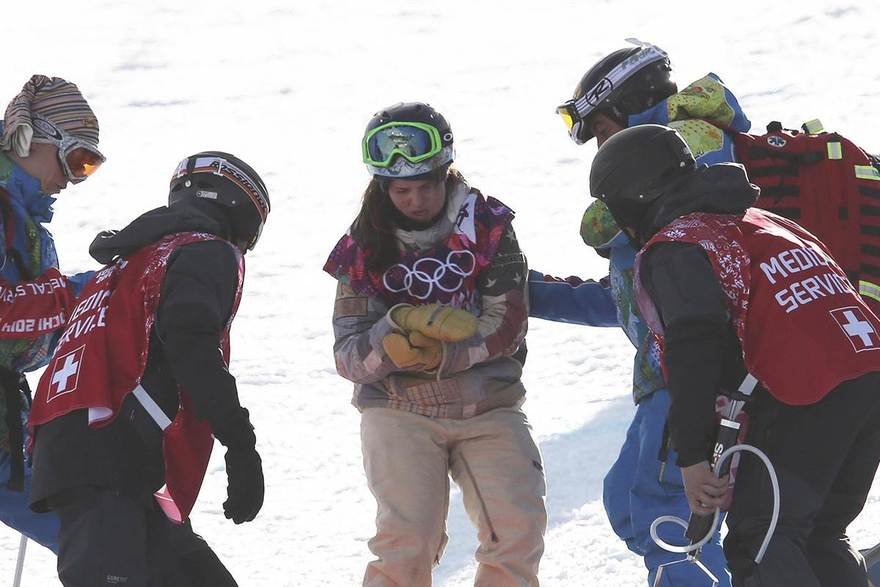#HTE
How Snowboard Halfpipes are Made

Last night Olympic snowboarding fans were treated to a thrilling spectacle: America’s 17-year-old phenom, Chloe Kim, crushing her final run with a 98.25 and gaining the gold medal.
But before I get to that yes, we’re a design blog, so let’s go over how halfpipes are made.

Design
The 2018 Olympic standards call for a 600-foot-long run, an 18-degree pitch and elliptical walls that are precisely 22 feet high and spaced 64 feet apart from lip to lip.
 As interest in the sport has grown, so too have the halfpipes. [Image credit: The Globe & Mail]
As interest in the sport has grown, so too have the halfpipes. [Image credit: The Globe & Mail]
The walls should not rise to dead verticality. The halfpipe at the 2014 Olympics in Sochi was constructed in that manner, and considered dreadful by the riders; the U.S. team’s Danny Davis referred to it as “garbage,” while Australian competitor Torah Bright called it “brutal.”
 The problem at Sochi. [Image credit: The Globe & Mail]
The problem at Sochi. [Image credit: The Globe & Mail]
Materials
Obviously snow, but not just any snow: It has to be a consistent blend with “No lumps, dry spots, heavy wet spots,” as Snow Park Tech president and expert halfpipe builder Chris Gunnarson told NBC. The material consistency is crucial for reasons of safety, and it’s another area where Sochi screwed up: On her final practice run there the U.S.A.’s Arielle Gold, then the defending world champion, wedged her board into a bump on the surface that shouldn’t have been there and crashed. She separated her shoulder and was robbed, by shoddy workmanship, of her chance to compete.

Construction and Equipment
The initial step can be done in either of two ways: The first option is to build an earthen structure that is then topped with roughly half a million cubic feet of snow. The second option is to use Snowcats to plow existing snow into two massive snowbanks.

No matter which option is selected, both require the same final step: The crucial shaping and shaving of the walls into a smooth and consistent arc.

First a line is marked on the deck using a rope line and a chainsaw. Then a Snowcat that has been fitted with a massive, elliptical-arc-profile arm containing an articulated augur is used to shave the walls.




Interestingly, the first machine of this sort was invented by an organic vegetable farmer, Doug Waugh, in the late ‘80s. An ex-engineer, Waugh’s familiarity with both agricultural machines and snowboarding led him to create the Pipe Dragon out of sheer boredom; he was based in Colorado and had plenty of farming to do in the summer and nothing to do in the winter. The Pipe Dragon was a success, sold well and Waugh was hired to create the halfpipe for Nagano in 1998, when snowboarding was first introduced to the Olympics.

In the '90s Zaugg, a Swiss manufacturer of agricultural and snow removal machinery, designed a competing product called the Pipe Monster that cuts a more elliptical curve. Waugh passed away in 2000 and the Pipe Monster is now the standard.


Alternate Snow-Gathering Method
If you’ve got access to Red Bull money, as two-time Olympic gold medalist Shaun White does, you can have guys in a helicopter drop 25-pound explosive charges onto the side of a mountain. This induces an avalanche that delivers the desired amount of snow down to your pipe site. I have no idea what the ecological consequences are but I’m hoping they looked into it and deemed it harmless.
So that’s how you build an Olympic halfpipe. How do you get to ride one? Well, now that the design stuff’s out of the way, I’m glad you asked…
How to Get a Chance to Ride an Olympic Halfpipe

It’s really pretty simple. First, ensure you’re born to a father who takes up snowboarding and brings you along when you’re four. Then, start snowboarding and be mistaken for a boy. Train for 13 years.
What to Do on an Olympic Halfpipe
Chloe Kim qualified for the 2014 Olympics in competition, but at 13 years old she didn’t meet the age requirement.
Now 17, on her first run at Pyeongchang she scored a stunning 93.75. No one else came in close; China’s Liu Jiayu was in second with 85.50.
On Run 2, Kim attempted to do two 1080s back-to-back, but blew the landing and scored a dismal 41.50. Liu improved to an 89.75.
On Run 3, Kim was slated last. As each competitor made their runs, none of them exceeded 93.75 or even broke 90, meaning Kim was now guaranteed gold, and Run 3 would be a mere formality.
But, as she later told the cameras, “I knew that if I went home with a gold medal knowing I could do better, I wasn’t going to be very satisfied. I wanted to do the back-to-back 10s. I wanted to go bigger. That third run was for me to prove to myself that I did it, so I could go home and be happy with myself.” So this was her Run 3:
Congratulations to Ms. Kim!
http://www.core77.com/posts/73316/How-Snowboard-Halfpipes-are-Made
